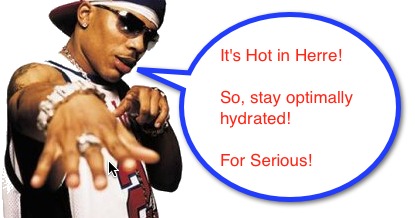Heat-Related Illness
With the subtly that only Mother Nature has, the days in the Northern Hemisphere have started to get longer and become consistently warmer. This, along with the fast approaching end of the school year, heralds the beginning of summer time. Summer time certainly brings wonderful times… and a new assortment of potential hazards! While we rightly focus on bike safety and swimming safety, let us not forget the dangers of heat-related illness.
Heat-Related Illness
- Spectrum of disease from mild, self-limited illness to major, life-threatening conditions.
- The vast majority of patients presenting to the ED with heat-related illness will be able to be discharged from the ED (~93%).
- There majority of the morbidity and mortality associated with heat-related illness is preventable.
-
Heat Cramps
- Painful muscle spasms.
- Body temperature is normal. There is associated sweating. No CNS derangement.
- Treat with fluid re-hydration and pain control.
-
Heat Exhaustion
- Systemic symptoms exist – dizziness, postural hypotension, nausea, vomiting, headache, weakness, and syncope.
- Body temperature can be normal or moderately elevated. There is profuse sweating.
- Often seen in unacclimatized individuals.
- Low morbidity when treated appropriately.
- Cause is salt or water depletion.
- Treat with cooling measures and re-hydration.
-
Heatstroke
- State of complete thermoregulatory failure and multiorgan system dysfunction.
- Mortality ranges from 17% to 80%.
- Present with CNS derangement: disorientation, seizures, or coma.
- Other organ system derangement: hemorrhagic complications, rhabdomyolysis, intestinal ischemia, etc.
- Classic Heatstroke
- Seen typically in extremes of ages (infants and elderly).
- Develops over a period of days.
- Skin is hot and dry.
- Exertional Heatstroke
- Most commonly seen in the <19 years of age population.
- Skin may be dry or sweating.
- Temperatures range 41.1 to 42.2 C.
- Greatest risk seen in those performing high-intensity exercise for a relatively short time span.
- Treatment requires medical stabilization (ABCs), cooling measures, and re-hydration.
-
Cooling Measures
- Use all means to dissipate heat (convection, conduction, evaporation, and radiation).
- Spray the skin with room-temperature water and direct fans to blow across the patients skin.
- Ice pack to groin and axilla can be added, but do not apply ice-water widely over the patient’s body surface, as this may cause vasoconstriction and impair heat dissipation.
- Continuous hemofiltration can be a useful strategy to lower the temperature and also deal with potential multi-system injury.
Prevention is Better than Therapy
I think that prevention education can be administered to anyone at any time… for instance when you are sewing the star softball player’s forehead. Here are a few pointers that parents can use to keep their kids from having heat-related injuries… and, thus, stay out of your ED.
Stay cool!
- Schedule events during cooler hours of the days.
- Arrange to be back in cooler environments during the hottest times.
- Taking frequent breaks.
Start drinking fluids before the activity!
- Unfortunately, if they start the activity dehydrated, they are going to have a hard time becoming adequately hydrated.
Drink often during the activity!
- It is important to drink even if “not thirsty.”
- Drinking 8 – 16 ounces of fluid (water or appropriate sports drink) every 20 minutes has been recommended. This may need to be adjusted for the age and size of the child.
- AVOID caffeinated and alcoholic beverages (naturally). Excessively sugary drinks (like sodas) are also not recommended.
Know the weight of the matter!
- Knowing pre-activity weight and post-activity weight can give an indication of the actual amount of water that has been lost and, thus, needs to be replaced.
- Center for Disease Control and Prevention: Nonfatal sports and recreation heat illness treated in hospital Emergency Departments – United States, 2001-2009. Morbidity and Mortality Weekly Report. July 29, 2011; 60(29): 977-980.
- American Academy of Pediatrics Committee on Sports Medicine and Fitness. Climatic heat stress and the exercising child and adolescent. Pediatrics. 2000; 106: 158–159.
- Falk B, Dotan R. Temperature regulation in elite young athletes. In The Elite Young Athlete. Chapter 8, edited by Armstrong N, McManus AM. Unionville, CT. S. Karger Publishers, Inc. 2011; 56: 126-149.



[…] know that there are certain conditions associated with high fever (ex, Heat Stroke, Vehicular Heat) that are dangerous, but the common viral illness causing a temp of 104F is not […]
[…] environmental exposures and injuries. We have previously discussed injuries related to submersions, heat-related illness and hyperthermia, thermal burn, and hypothermia. Essentially, no matter what environment a child […]